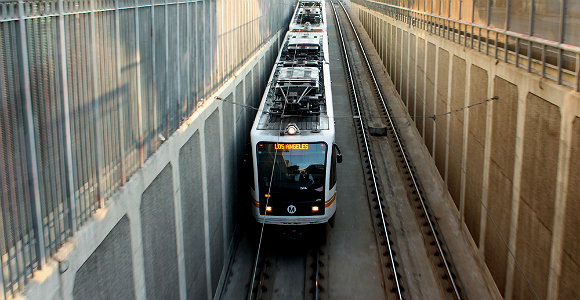
Expo Line in Los Angeles. (Photo Credit: Prayitno/Flickr)
No one in California is immune from the problem. From regions struggling to fund investments that reduce sprawl and improve air quality to cities looking for ways to build long-deferred water projects or affordable housing, the obstacle is often the same. While California has some of the nation’s most far-reaching state policies for combatting climate change and encouraging sustainable growth, state investment is shrinking, local tax measures can only go so far, and local governments can’t support projects with their own money.
This is where new local infrastructure financing authority can help.
In a new fact sheet released this week, the California Economic Summit details how Enhanced Infrastructure Financing Districts (EIFDs), authorized by legislation in 2014, offer local governments the financing powers they need to build the foundation for livable, sustainable communities—from transit stations, mixed-use developments and parks to next-generation water systems.
The fact sheet explains how the districts work, allowing cities, counties, and special districts to form public financing authorities with the power to access and bundle an unprecedented array of funding streams—including the tax increment powers once used by redevelopment agencies. It also makes the case that this new authority is broader and more flexible than redevelopment, while also providing the basics on how to set up a district.
“Since the Summit began working with lawmakers and the administration last year on crafting these new authorities, we’ve been trying to make them as broad as possible,” says Mark Pisano, senior fellow USC’s Sol Price School of Public Policy, who serves as co-lead of the Summit Infrastructure Action Team. “These new tools will allow communities to make exactly the types of investments we need to prepare for a growing population in a time of climate change. They create jobs, and they make our communities greener and more sustainable. Now we need to spread the word so local leaders can start using them.”
Breaking ground on new districts
Though this new authority has only existed for two months, several major projects are already working with the Summit as they contemplate creating enhanced financing districts. The City of Los Angeles, for example, is studying how an EIFD could be used to support the $1 billion restoration of the Los Angeles River. In the Bay Area, transit agencies and the City of San Jose are exploring how an EIFD can help finance the $4 billion extension of BART into Silicon Valley.
Summit leaders also testified in a recent legislative committee hearing on how EIFDs can support investments in next-generation stormwater capture facilities—giving resource agencies, cities, and counties a way to pool their resources around a land use challenge many experts believe will be vital to taking on the state’s long-term water problems.
As with any new law, good questions are being asked about how EIFDs can be used, how they interact with other state laws (Proposition 218, for example), and how these new districts interact with the public. In addition to its new fact sheet, the Summit also recently released a more detailed Q&A on these complex legal issues for land use and financing practitioners.
In the meantime, the Summit is continuing to support efforts to identify more projects that could benefit from an EIFD. An April 1 event hosted by the Bay Area Council will explore potential uses in the Bay Area, including transit-oriented development and affordable housing. An April 24 event organized by the Southwest Megaregion Alliance will bring project proponents, local governments, and public and private investors together to look at infrastructure opportunities across Southern California.
At these events, infrastructure financing experts will have an opportunity to learn more about how these new tools can be used—and to understand how they differ from other tools used in the past to fund infrastructure investment in California.
“For a long time, we were all trying to find Redevelopment 2.0,” said Larry Kosmont, president and CEO of Kosmont Companies, a finance firm that invests in infrastructure projects, in a recent webinar on EIFDs. “Instead, this has pushed us to an era of capital improvements and infrastructure investment—converging around the need to develop infrastructure that’s sustainable and that we can finance publicly. At the end of the day, we can use EIFDs to fund projects using a variety of sources. Most importantly, we can also use tax increment to attract private investment and leverage state funds. In the end, it ends up being a pretty robust program.”
A program that, with the help of the Summit, could soon be coming to a city near you.

